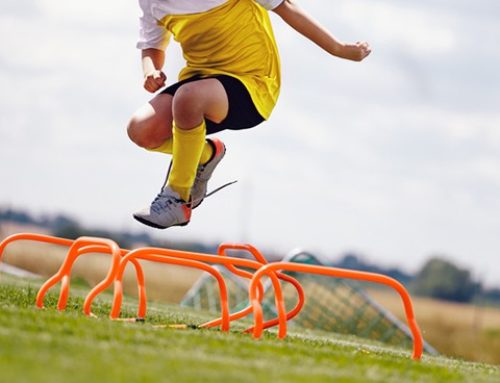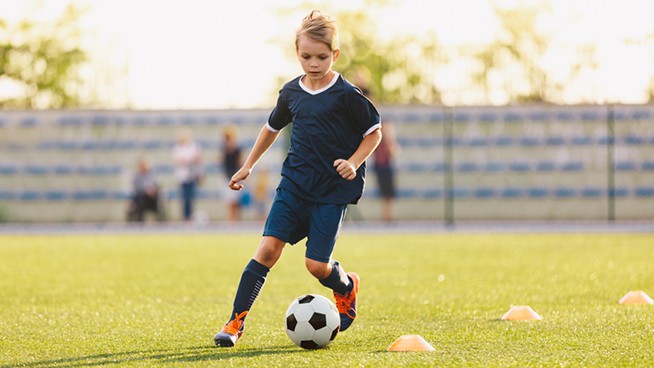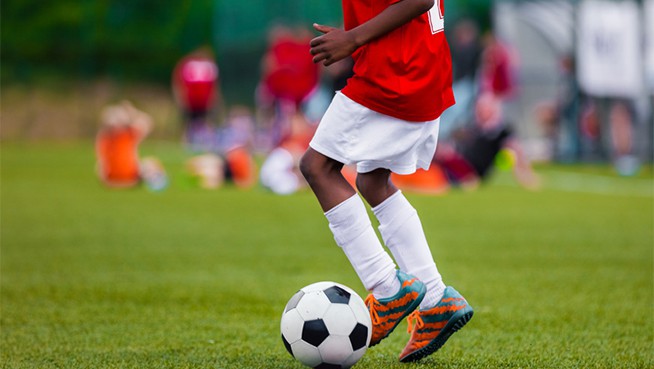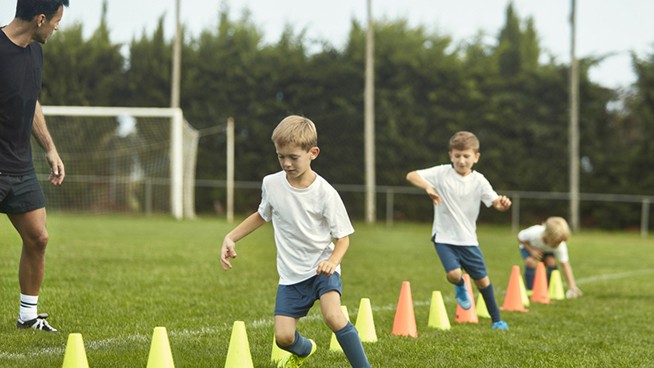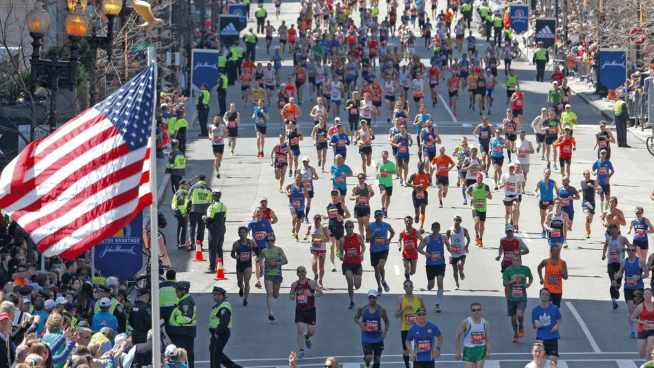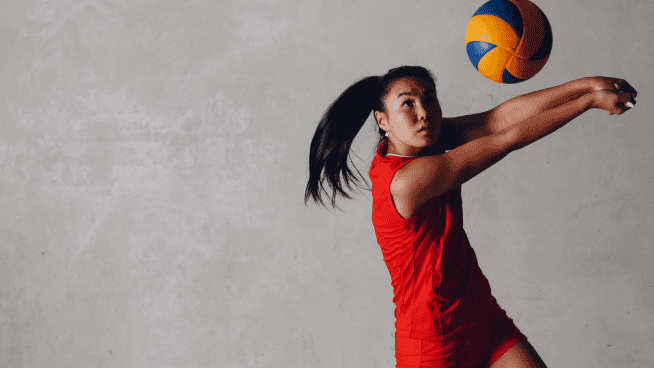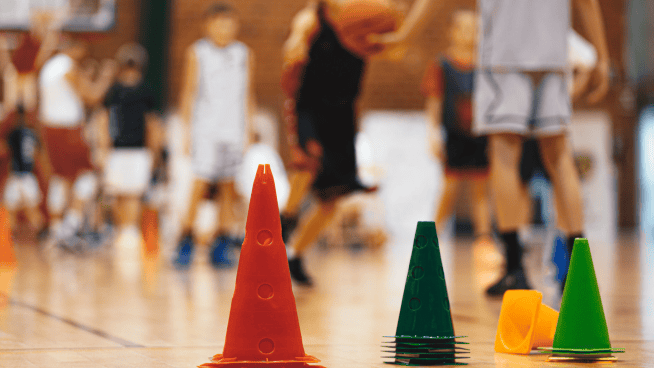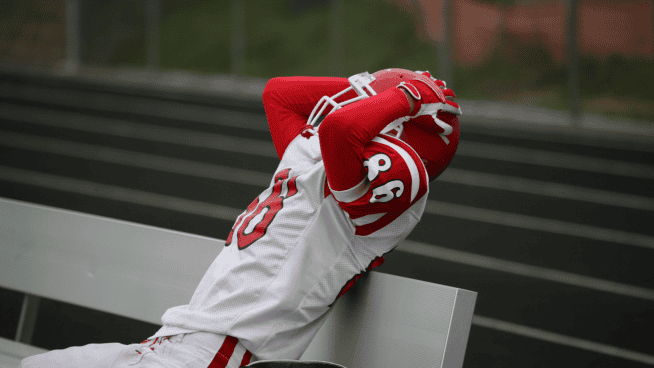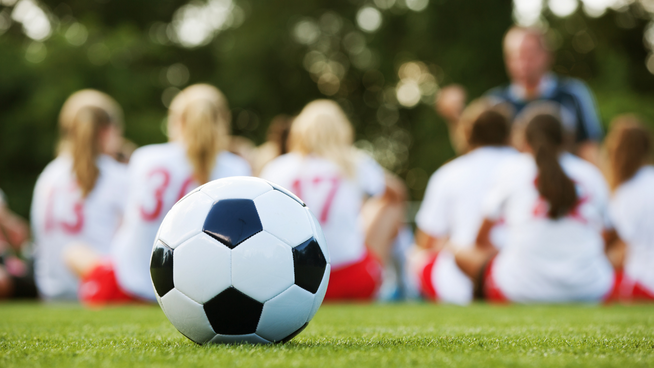Soccer Strength Training with Abby Wambach

Unmatched in size, speed and athleticism, two-time reigning U.S. Soccer Female Athlete of the Year Abby Wambach is one of the world’s most dominant strikers. Although an immediate impact player for the U.S. Women’s National Soccer Team since she joined in 2001, Wambach strives to improve her game and athleticism year after year. This desire led her to the doors of Athletes’ Performance Los Angeles (APLA) to begin her advanced training in 2004.
“Training at APLA has done more than just improve me as a soccer player. It has made me a better athlete, which is really the ultimate goal,” Wambach explains. “It’s an entirely different world of training. Everything applies to being a better athlete on the field.”
Anthony Slater, APLA’s director of performance, says producing better athletes results from teaching them proper and efficient movement. APLA students learn efficient movement from strength training structured around movement patterns. Each pattern teaches the involved muscle groups to fire properly in the correct order.
“You have to perform movement patterns so they look and feel good,” Slater says. “The first priority in resistance training is learning to properly perform movement patterns repeatedly. Then, when you train for intensity, speed and explosiveness, your body reaps all the benefits and can withstand the stresses.”
Based on patterns Wambach often uses on the soccer field, Slater set several goals to achieve with her training:
• “Single-leg stability so she can be as efficient as possible when changing directions”
• “Balance on one and two legs to improve her recovery when landing jumps”
• “Elasticity of her muscles so she can endure the entire 90 minutes of a game,”
• “Mechanics so that muscles fire in the right order, which prevents injury.”
Although different movement patterns exist for all muscle groups, Slater details five of the lower body and core patterns he implements in Wambach’s training. He talks about the purpose of each pattern and provides a representative movement. APLA uses Keiser equipment for most movements, but Slater offers alternative movements that use equipment common to high school weight rooms.
MOVEMENT PATTERN:
ROTATIONAL STABILITY (Resisting Rotational Movement)
Purpose: Efficient movement and stability
“These exercises work your ability to resist a rotational force while maintaining a stable torso and hips. This teaches you to avoid unnecessary movements—ones that aren’t directly linked to the clean, powerful movements performed on the field, like cutting, accelerating and jumping.”
APLA Option: Keiser Inline Half-Kneeling Chop (A)
• Kneel on one leg with shoulders perpendicular to Keiser machine
• With both hands, pull cord across at mid-torso level
• Do not rotate shoulders during pull
• Push cord toward ground with arm closest to machine
• Do not side bend during push
• Repeat to opposite side
HS Option: Side Pillar Bridge (B)
• Lie on side with elbow and forearm below shoulder
• Place legs one on top of other; only one side of foot in contact with ground
• Lift hips off ground
• Support body with side of one foot and forearm of down-arm
• Extend opposite arm, hold parallel to shoulders
• Keep balance as partner pushes/pulls at arm and hip
WHAT THEY DO: “When you pull the rope across your body during the Keiser exercise, your natural impulse is to twist your shoulders to help pull the rope. Resist that urge and remain stationary. The force you create when you press the rope in front of your down leg causes you to want to bend to the side. Resist that too, and, again, remain stationary.
“If a partner applies small forces against you by pushing or pulling during the Side Pillar Bridge, learn to react reflexively and stabilize against each force without overcorrecting and losing stability. Learn which muscles resist rotation and maintain rotational stability.”
MOVEMENT PATTERN:
ROTATIONAL POWER
Purpose: Change of direction
“This teaches you to load your hips properly to reduce and produce the rotational force necessary to change directions. This skill is critical in multidirectional sports like soccer.
“Separation of hip rotation from spine rotation is also a product of these movements. You should be able to plant your leg and rotate through your hips, instead of flexing and rotating your spine. Effectively loading your hips stretches the glutes and hip rotators, allowing more explosive direction changes on the field.”
APLA Option: Rotational Row (C) (with shoulder strap)
• Stand with shoulders perpendicular to Keiser machine
• Place shoulder strap around torso
• Hold pulley handle in hand further from machine
• Rotate toward machine and dip into quarter squat position
• Extend arm in front of body inline with pulley cable
• Rotate in opposite direction and extend at knees and hips to upright position
• Simultaneously pull handle across body until next to hip
• Keep elbow tight to body
HS Option: Med Ball Perpendicular Throw (D)
• Stand with arms extended holding medicine ball
• Rotate to one side and dip into quarter-squat position
• Follow ball with eyes
• Rotate in opposite direction and extend at knees and hips to upright position
• At end of rotation, throw medicine ball to a partner or against a wall
• Catch medicine ball from partner, stabilize, repeat
WHAT THEY DO: “Both movements combine the ability to stabilize a rotational force (when you rotate at the beginning of the movement) with squatting and producing a rotational movement (when you explode through and complete the movement). The shoulder strap makes the Rotational Row more difficult, because it pulls further from your base of support (your feet), versus using a strap around the hip. The shoulder strap creates a longer lever across your body and forces the core to stabilize.
“The Med Ball Perpendicular Throw is almost the same as the Rotational Row, but it’s more ballistic because you let go of the ball. You work explosiveness concentrically when you rotate and extend your hip to throw, and eccentrically when you decelerate to catch the ball and load your hips to throw it again.”
MOVEMENT PATTERN:
TOTAL BODY POWER (Double-Leg Push)
Purpose: Increased vertical jump
“These are basically squat pattern variations. Two-leg jumping is something that helps soccer players compete in the air, because they will get up higher to put their head on the ball before the competition.”
APLA Option: Keiser Resisted Squat Jump (E)
• Stand with back to Keiser machine, and strap around waist
• Dip into quarter-squat position
• Jump for maximum height
• Achieve triple extension at ankles, knees and hips
• Repeat
HS Option: Squat Jump (with weight vest) (F)
• Stand wearing weight vest on torso
• Dip into quarter-squat position
• Jump for maximum height
• Achieve triple extension at ankles, knees and hips
• Repeat
WHAT THEY DO: “Resisted squat jumps teach you to produce force as quickly as possible. In competitive situations, when you aren’t carrying the load the Keiser or vest creates, you produce that same force at a faster rate, which means you will move faster and higher. The Keiser’s pure and constant resistance through the entire range of motion counteracts momentum. Because the waist strap puts the load below the waist, excessive flexion and extension in your spine—something to avoid when learning explosive movements—isn’t an issue.”
MOVEMENT PATTERN:
LOWER BODY PUSH
Purpose: Improve acceleration
“The exercises are performed in a running position—a split leg stance with the forward leg driving. The same forward body-lean used during the acceleration phase of running is required to efficiently drive off the forward leg.”
APLA Option: Slide Board Back Lunge with Horizontal Keiser Resistance (G)
• Stand with back leg on slide board and back to Keiser machine
• Place strap around waist
• Slide back leg backward; drop back knee toward floor, but do not touch
• Keep back straight with slight lean forward
• Do not let front knee shift past toes
• Drive off front leg to starting position
• Repeat for opposite leg
HS Option: Walking Lunge (H)
• Stand with feet hip width apart
• Step forward into lunge
• Drop back knee toward floor, but do not touch
• Keep back straight with slight lean forward
• Do not let front knee shift past toes
• Drive off front leg to starting position
• Repeat for opposite leg
WHAT THEY DO: “These lunges mimic a proper running pattern as one leg drives while the other moves.”
MOVMENT PATTERN:
LOWER BODY PULL
Purpose: Proper running posture, balance, speed and power
“This teaches you to extend with your hips instead of extending and flexing your lower back. Extending with the hip at the end of your stride allows for the most power and speed when running. Extending with your back at this point causes hip flexor groin and back problems.
“This also teaches to separate hip movement from low back movement. The knee and low back are locked, so movement only comes from the hips during the exercise. Separating your hip movement from yourback movement allows for proper posture while running, which is crucial to sports performance.
“Additionally, holding the dumbbell or Keiser handle in one hand while standing on one leg produces a rotational force. You must work against this rotational force to properly perform the lift, which develops balance and stability.”
APLA Option: Keiser Single-Arm/Leg RDL (I)
• Stand on bench on one leg with slight bend in knee
• Hold Keiser pulley handle in hand opposite down leg
• Bend at hips, keeping back flat and up leg inline with back
• Push hips back and drop chest until parallel with ground
• Extend at hips to return to starting position
• Repeat for opposite leg
HS Option: Dumbbell Single-Arm/Leg RDL (J)
• Stand on one leg with slight bend in knee
• Hold DB in hand opposite down leg
• Bend at hips, keeping back flat and up leg inline with back
• Push hips back and drop chest until parallel with ground
• Extend at hips to return to starting position
• Repeat for opposite leg
WHAT THEY DO: “The Keiser Single-Arm/Leg RDL and the DB Single-Arm/Leg RDL are the same patterns; resistance is the only difference. The Keiser provides a constant tension throughout the range of motion, particularly at the end of hip extension as you stand up. A dumbbell cannot replicate that same resistance. The momentum generated throughout the movement reduces the load at the end of hip extension.”
KEISER EQUIPMENT-THE MOMENTUM KILLER
Momentum, the limiting factor of explosive work, causes many injuries in weight training. Keiser machines eliminate momentum, and consequently decrease risk of injury.
Picture yourself performing a bench press. Momentum develops when you move the weight down and then back up. You control the weight down so the bar doesn’t gain too much momentum and bounce off your chest. On the way up, you create momentum again when you accelerate the bar upward. As you get to the top, however, you decelerate the bar so that its momentum doesn’t make it fly out of your hands. This process prevents you from working explosiveness through the entire range of motion.
When moving conventional weight, resistance decreases as momentum builds. Keiser equipment provides resistance with air compressors or pistons to eliminate momentum. When you work against the resistance on these machines, the load or degree of resistance remains constant.
RECOMMENDED FOR YOU
MOST POPULAR
Soccer Strength Training with Abby Wambach

Unmatched in size, speed and athleticism, two-time reigning U.S. Soccer Female Athlete of the Year Abby Wambach is one of the world’s most dominant strikers. Although an immediate impact player for the U.S. Women’s National Soccer Team since she joined in 2001, Wambach strives to improve her game and athleticism year after year. This desire led her to the doors of Athletes’ Performance Los Angeles (APLA) to begin her advanced training in 2004.
“Training at APLA has done more than just improve me as a soccer player. It has made me a better athlete, which is really the ultimate goal,” Wambach explains. “It’s an entirely different world of training. Everything applies to being a better athlete on the field.”
Anthony Slater, APLA’s director of performance, says producing better athletes results from teaching them proper and efficient movement. APLA students learn efficient movement from strength training structured around movement patterns. Each pattern teaches the involved muscle groups to fire properly in the correct order.
“You have to perform movement patterns so they look and feel good,” Slater says. “The first priority in resistance training is learning to properly perform movement patterns repeatedly. Then, when you train for intensity, speed and explosiveness, your body reaps all the benefits and can withstand the stresses.”
Based on patterns Wambach often uses on the soccer field, Slater set several goals to achieve with her training:
• “Single-leg stability so she can be as efficient as possible when changing directions”
• “Balance on one and two legs to improve her recovery when landing jumps”
• “Elasticity of her muscles so she can endure the entire 90 minutes of a game,”
• “Mechanics so that muscles fire in the right order, which prevents injury.”
Although different movement patterns exist for all muscle groups, Slater details five of the lower body and core patterns he implements in Wambach’s training. He talks about the purpose of each pattern and provides a representative movement. APLA uses Keiser equipment for most movements, but Slater offers alternative movements that use equipment common to high school weight rooms.
MOVEMENT PATTERN:
ROTATIONAL STABILITY (Resisting Rotational Movement)
Purpose: Efficient movement and stability
“These exercises work your ability to resist a rotational force while maintaining a stable torso and hips. This teaches you to avoid unnecessary movements—ones that aren’t directly linked to the clean, powerful movements performed on the field, like cutting, accelerating and jumping.”
APLA Option: Keiser Inline Half-Kneeling Chop (A)
• Kneel on one leg with shoulders perpendicular to Keiser machine
• With both hands, pull cord across at mid-torso level
• Do not rotate shoulders during pull
• Push cord toward ground with arm closest to machine
• Do not side bend during push
• Repeat to opposite side
HS Option: Side Pillar Bridge (B)
• Lie on side with elbow and forearm below shoulder
• Place legs one on top of other; only one side of foot in contact with ground
• Lift hips off ground
• Support body with side of one foot and forearm of down-arm
• Extend opposite arm, hold parallel to shoulders
• Keep balance as partner pushes/pulls at arm and hip
WHAT THEY DO: “When you pull the rope across your body during the Keiser exercise, your natural impulse is to twist your shoulders to help pull the rope. Resist that urge and remain stationary. The force you create when you press the rope in front of your down leg causes you to want to bend to the side. Resist that too, and, again, remain stationary.
“If a partner applies small forces against you by pushing or pulling during the Side Pillar Bridge, learn to react reflexively and stabilize against each force without overcorrecting and losing stability. Learn which muscles resist rotation and maintain rotational stability.”
MOVEMENT PATTERN:
ROTATIONAL POWER
Purpose: Change of direction
“This teaches you to load your hips properly to reduce and produce the rotational force necessary to change directions. This skill is critical in multidirectional sports like soccer.
“Separation of hip rotation from spine rotation is also a product of these movements. You should be able to plant your leg and rotate through your hips, instead of flexing and rotating your spine. Effectively loading your hips stretches the glutes and hip rotators, allowing more explosive direction changes on the field.”
APLA Option: Rotational Row (C) (with shoulder strap)
• Stand with shoulders perpendicular to Keiser machine
• Place shoulder strap around torso
• Hold pulley handle in hand further from machine
• Rotate toward machine and dip into quarter squat position
• Extend arm in front of body inline with pulley cable
• Rotate in opposite direction and extend at knees and hips to upright position
• Simultaneously pull handle across body until next to hip
• Keep elbow tight to body
HS Option: Med Ball Perpendicular Throw (D)
• Stand with arms extended holding medicine ball
• Rotate to one side and dip into quarter-squat position
• Follow ball with eyes
• Rotate in opposite direction and extend at knees and hips to upright position
• At end of rotation, throw medicine ball to a partner or against a wall
• Catch medicine ball from partner, stabilize, repeat
WHAT THEY DO: “Both movements combine the ability to stabilize a rotational force (when you rotate at the beginning of the movement) with squatting and producing a rotational movement (when you explode through and complete the movement). The shoulder strap makes the Rotational Row more difficult, because it pulls further from your base of support (your feet), versus using a strap around the hip. The shoulder strap creates a longer lever across your body and forces the core to stabilize.
“The Med Ball Perpendicular Throw is almost the same as the Rotational Row, but it’s more ballistic because you let go of the ball. You work explosiveness concentrically when you rotate and extend your hip to throw, and eccentrically when you decelerate to catch the ball and load your hips to throw it again.”
MOVEMENT PATTERN:
TOTAL BODY POWER (Double-Leg Push)
Purpose: Increased vertical jump
“These are basically squat pattern variations. Two-leg jumping is something that helps soccer players compete in the air, because they will get up higher to put their head on the ball before the competition.”
APLA Option: Keiser Resisted Squat Jump (E)
• Stand with back to Keiser machine, and strap around waist
• Dip into quarter-squat position
• Jump for maximum height
• Achieve triple extension at ankles, knees and hips
• Repeat
HS Option: Squat Jump (with weight vest) (F)
• Stand wearing weight vest on torso
• Dip into quarter-squat position
• Jump for maximum height
• Achieve triple extension at ankles, knees and hips
• Repeat
WHAT THEY DO: “Resisted squat jumps teach you to produce force as quickly as possible. In competitive situations, when you aren’t carrying the load the Keiser or vest creates, you produce that same force at a faster rate, which means you will move faster and higher. The Keiser’s pure and constant resistance through the entire range of motion counteracts momentum. Because the waist strap puts the load below the waist, excessive flexion and extension in your spine—something to avoid when learning explosive movements—isn’t an issue.”
MOVEMENT PATTERN:
LOWER BODY PUSH
Purpose: Improve acceleration
“The exercises are performed in a running position—a split leg stance with the forward leg driving. The same forward body-lean used during the acceleration phase of running is required to efficiently drive off the forward leg.”
APLA Option: Slide Board Back Lunge with Horizontal Keiser Resistance (G)
• Stand with back leg on slide board and back to Keiser machine
• Place strap around waist
• Slide back leg backward; drop back knee toward floor, but do not touch
• Keep back straight with slight lean forward
• Do not let front knee shift past toes
• Drive off front leg to starting position
• Repeat for opposite leg
HS Option: Walking Lunge (H)
• Stand with feet hip width apart
• Step forward into lunge
• Drop back knee toward floor, but do not touch
• Keep back straight with slight lean forward
• Do not let front knee shift past toes
• Drive off front leg to starting position
• Repeat for opposite leg
WHAT THEY DO: “These lunges mimic a proper running pattern as one leg drives while the other moves.”
MOVMENT PATTERN:
LOWER BODY PULL
Purpose: Proper running posture, balance, speed and power
“This teaches you to extend with your hips instead of extending and flexing your lower back. Extending with the hip at the end of your stride allows for the most power and speed when running. Extending with your back at this point causes hip flexor groin and back problems.
“This also teaches to separate hip movement from low back movement. The knee and low back are locked, so movement only comes from the hips during the exercise. Separating your hip movement from yourback movement allows for proper posture while running, which is crucial to sports performance.
“Additionally, holding the dumbbell or Keiser handle in one hand while standing on one leg produces a rotational force. You must work against this rotational force to properly perform the lift, which develops balance and stability.”
APLA Option: Keiser Single-Arm/Leg RDL (I)
• Stand on bench on one leg with slight bend in knee
• Hold Keiser pulley handle in hand opposite down leg
• Bend at hips, keeping back flat and up leg inline with back
• Push hips back and drop chest until parallel with ground
• Extend at hips to return to starting position
• Repeat for opposite leg
HS Option: Dumbbell Single-Arm/Leg RDL (J)
• Stand on one leg with slight bend in knee
• Hold DB in hand opposite down leg
• Bend at hips, keeping back flat and up leg inline with back
• Push hips back and drop chest until parallel with ground
• Extend at hips to return to starting position
• Repeat for opposite leg
WHAT THEY DO: “The Keiser Single-Arm/Leg RDL and the DB Single-Arm/Leg RDL are the same patterns; resistance is the only difference. The Keiser provides a constant tension throughout the range of motion, particularly at the end of hip extension as you stand up. A dumbbell cannot replicate that same resistance. The momentum generated throughout the movement reduces the load at the end of hip extension.”
KEISER EQUIPMENT-THE MOMENTUM KILLER
Momentum, the limiting factor of explosive work, causes many injuries in weight training. Keiser machines eliminate momentum, and consequently decrease risk of injury.
Picture yourself performing a bench press. Momentum develops when you move the weight down and then back up. You control the weight down so the bar doesn’t gain too much momentum and bounce off your chest. On the way up, you create momentum again when you accelerate the bar upward. As you get to the top, however, you decelerate the bar so that its momentum doesn’t make it fly out of your hands. This process prevents you from working explosiveness through the entire range of motion.
When moving conventional weight, resistance decreases as momentum builds. Keiser equipment provides resistance with air compressors or pistons to eliminate momentum. When you work against the resistance on these machines, the load or degree of resistance remains constant.

